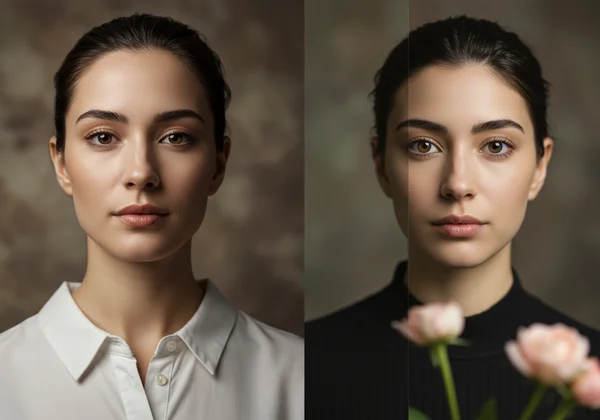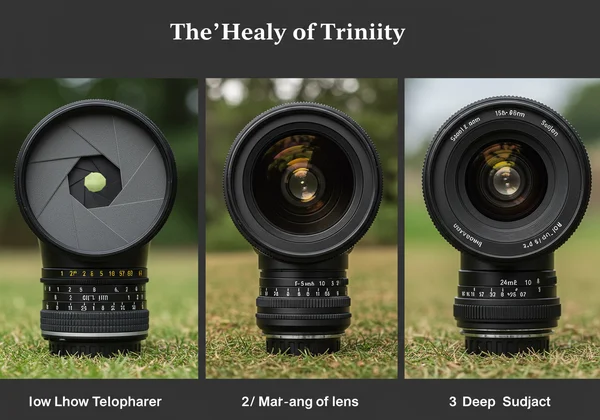DOF Calculator Explains: Optical Bokeh vs. Smartphone Portrait Mode & Depth of Field
Ever captured a moment and wished your subject popped with breathtaking clarity against a dreamy, blurred background? That enchanting effect, known as 'bokeh,' is the hallmark of truly professional photography. While smartphones now offer a 'Portrait Mode' promising this magic with a tap, how does this digital wizardry truly stack up against the genuine optical depth of field from a dedicated camera? If you're eager to demystify what is depth of field in photography? and master its incredible power, you've come to the right place!
Understanding this difference is key to elevating your photography, and a reliable depth of field calculator can be your most powerful ally in mastering it. This guide will break down the technology, compare the visual results, and show you how to gain ultimate creative control over your images. For anyone serious about photography, the debate over portrait mode vs dslr is a crucial one. Ready to unlock your camera's full potential and craft images with unparalleled precision? Don't just dream of the perfect shot—plan it today with our intuitive depth of field calculator!

Smartphone Portrait Mode: The Digital Deception (or Magic?)
The convenience of smartphone photography is undeniable. With "Portrait Mode," manufacturers like Apple and Google have brought a complex photographic effect to the masses. Instead of relying on physics, these devices use powerful software and computational photography to simulate a shallow depth of field. It’s a stunning feat of engineering, but it's a world away from how a traditional camera works.
How Computational Photography Creates the Blur
When you activate Portrait Mode, your phone isn't using a single lens to create blur. Instead, it’s using a clever combination of hardware and software. Most systems use two lenses to create a depth map, a digital representation of which objects are close to the camera and which are far away. The phone's processor then identifies the subject based on this map.
Once the subject is isolated, the software essentially creates a digital mask around it. Everything outside this mask—the background—has a blur filter applied to it. This process happens in a fraction of a second, delivering an image that mimics the look of optical bokeh. It’s a powerful illusion that works surprisingly well in many situations.

The Pros and Cons: Convenience vs. Artifacts
The biggest advantage of Portrait Mode is its sheer convenience. You can achieve a portrait-like effect without understanding f-stops or focal lengths. It's instant, accessible, and often good enough for social media sharing. However, this digital approach has its limitations.
The main drawback is the presence of artifacts—errors in the digital blur. Because the software is making an educated guess about the subject's edges, it often gets things wrong. You might see strange halos around hair, parts of the background that remain sharp, or objects between the subject and background getting incorrectly blurred. The blur itself is often a uniform, generic filter, lacking the beautiful, creamy quality of true optical bokeh.
Understanding True Optical Bokeh & Mastering Depth of Field with a DOF Calculator
Unlike the digital simulation in smartphones, true optical bokeh is a result of physics. It’s the way a lens renders out-of-focus points of light, and it’s directly controlled by the principles of Depth of Field (DOF). This is where dedicated cameras—DSLRs and mirrorless systems—truly shine, offering photographers unparalleled creative control.
What is Depth of Field (DOF) in Photography?
In simple terms, Depth of Field is the distance between the nearest and farthest objects in a photo that appear acceptably sharp. This zone of sharpness isn't infinite. When you focus on a subject, there is a specific area in front of and behind them that will also be in focus.
A "shallow" or "small" depth of field means this zone of sharpness is very narrow, causing the background (and foreground) to fall into a pleasant blur. This is the effect portrait photographers love. Conversely, a "deep" or "large" depth of field means a much wider zone is sharp, which is ideal for landscape photography where you want everything from the foreground flowers to the distant mountains in focus.
The Holy Trinity: Aperture, Focal Length, and Subject Distance
Mastering optical depth of field comes down to understanding three key factors:
-
Aperture: This is the opening in the lens that lets light in, measured in f-stops (e.g., f/1.8, f/4, f/11). A wider aperture (a lower f-number like f/1.8) creates a much shallower depth of field, resulting in more background blur.
-
Focal Length: This refers to the lens's zoom, measured in millimeters (mm). A longer focal length (e.g., 85mm or 200mm) compresses the background and produces a shallower depth of field than a wide-angle lens (e.g., 24mm) at the same aperture.
-
Subject Distance: The closer you are to your subject, the shallower your depth of field will be. This is why macro photography has such an extremely narrow plane of focus.

Planning Your Perfect Shot: The DOF Calculator as Your Essential Tool
Juggling these three elements gives you precise, artistic control that software simply cannot replicate. Instead of guessing, you can plan these variables ahead of time with a dof simulator to guarantee the perfect result. This is where a great dof calculator transforms from a tool into a creative partner.
The Crucial Role of Sensor Size & Lens Quality
Two other physical factors play a massive part: sensor size and lens quality. Cameras with larger sensors (like Full-Frame or APS-C) make it inherently easier to achieve a shallow depth of field compared to the tiny sensors in smartphones. This is a physical advantage that no software can fake, and it's a variable our dof calculator accounts for when helping you plan. Furthermore, the optical design of a high-quality lens, including the shape and number of its aperture blades, determines the quality of the bokeh—whether it's smooth and creamy or busy and distracting.
Seeing the Difference: Side-by-Side Visual Comparisons
The theoretical differences become obvious when you see them in practice. While Portrait Mode is getting better, it still falls short of the organic, nuanced results of true optical depth of field.

Examining the Edges: Masking vs. Natural Falloff
Look closely at the edges of a subject in a smartphone portrait. You'll often see a crisp, almost "cut-out" line where the blur begins. This is a tell-tale sign of digital masking. In contrast, an image from a dedicated camera exhibits a natural falloff. The transition from sharp to out-of-focus is gradual and smooth, blending seamlessly in a way that is physically accurate and pleasing to the eye—a result you can precisely predict with a good depth of field calculator.
The Quality of the Blur: Creamy vs. Busy Bokeh
Not all blur is created equal. Smartphone blur is typically a uniform, digital effect applied evenly across the background. True optical bokeh has character. Different lenses produce different styles of bokeh. Some create soft, circular highlights that look creamy and dream-like, while others might be more structured. This aesthetic quality is a signature of high-end lenses and a powerful tool for artistic expression.
Achieving Desired DOF: Using the DOF Calculator for Precision
Here lies the greatest advantage for the serious photographer: control. Instead of letting an algorithm guess, you can decide exactly what you want in focus. Want just your subject's eyes to be sharp? Or perhaps you need a deep depth of field to capture a sprawling landscape? This is where planning becomes essential.
By using a powerful tool like our dof calculator, you can enter your specific camera settings—your sensor size, focal length, aperture, and distance to the subject—before you even take the shot. The depth of field calculator will tell you precisely where your zone of focus will be, down to the centimeter. This removes the guesswork and empowers you to execute your creative vision flawlessly. This is the power a professional dof calculator gives you. You can calculate your DOF right now to see how it works.

Choosing Your Tool: When to Use What for Your Vision
The choice between smartphone Portrait Mode and a dedicated camera isn't about which is "better," but which is the right tool for the job. For a quick, convenient shot for social media, your phone is an incredible device. Its computational power delivers impressive results with zero effort.
However, for photographers who want creative control, superior image quality, and the authentic beauty of optical physics, there is no substitute for a dedicated camera. Mastering the relationship between aperture, focal length, and distance—concepts easily explored with a dof calculator—unlocks a world of artistic possibility. It allows you to craft an image with intention, not just capture a moment. By learning these principles and using planning tools like a hyperfocal distance calculator, you can transform your photography from reactive to proactive.
Frequently Asked Questions About Bokeh & Depth of Field
What is Depth of Field (DOF) in photography?
Depth of Field (DOF) refers to the range of distance in a photograph that appears acceptably sharp. A shallow DOF creates a blurry background, while a deep DOF keeps most of the scene in focus.
How does aperture affect depth of field?
Aperture is one of the primary controls for DOF. A wide aperture (indicated by a low f-number, like f/1.4 or f/2.8) lets in more light and creates a shallow depth of field, significantly blurring the background. A narrow aperture (a high f-number, like f/11 or f/16) lets in less light and creates a deep depth of field, keeping more of the scene sharp.
How does focal length affect depth of field?
A longer focal length (telephoto lenses, e.g., 85mm, 135mm) magnifies the background and appears to compress the distance, which results in a shallower depth of field at any given aperture. Wide-angle lenses have an inherently deeper depth of field.
How can I get a blurry background with a dedicated camera?
To get a beautiful blurry background, use the widest aperture your lens allows (the lowest f-number), use a longer focal length, and get closer to your subject. These three factors work together to create a shallow depth of field. You can pre-visualize the exact effect by using a free online tool like our depth of field calculator to remove all guesswork.
What's the main difference between optical bokeh and smartphone 'Portrait Mode'?
The main difference is physics versus software. Optical bokeh is a natural phenomenon created by a camera's lens and aperture, offering a smooth, realistic blur with artistic character. 'Portrait Mode' is a computational simulation that uses software to identify a subject and digitally apply a blur filter to the background, which can sometimes result in errors and a less natural look.